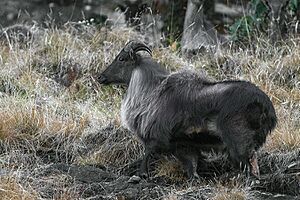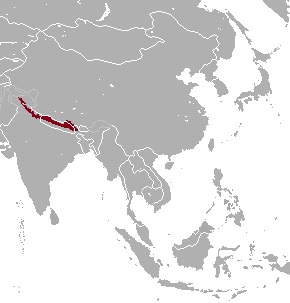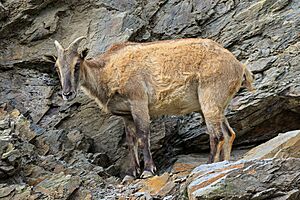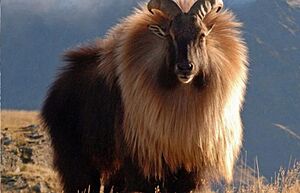Himalayan tahr facts for kids
Quick facts for kids Himalayan tahr |
|
|---|---|
 |
|
| An adult male Himalayan tahr in Kedarnath Wildlife Sanctuary, Uttarakhand | |
| Conservation status | |
| Scientific classification | |
| Genus: |
Hemitragus
|
| Species: |
jemlahicus
|
 |
|
| Range map | |
The Himalayan tahr (Hemitragus jemlahicus) is a large hoofed mammal that lives in the Himalayas. You can find them in southern Tibet, northern India, western Bhutan, and Nepal. These animals are listed as Near Threatened on the IUCN Red List. This means their numbers are going down because of hunting and losing their homes.
Himalayan tahrs have also been taken to other countries like Argentina, New Zealand, South Africa, and the United States. There, they are an introduced species.
Contents
What is a Tahr?
Tahrs belong to a group of animals called Caprinae. This group includes sheep and goats. They are part of the order called Artiodactyla, which means they have an even number of toes.
Scientists once thought there was a subspecies called the Eastern Himalayan tahr. But now, they believe there is only one type of Himalayan tahr. Recent studies show that the Himalayan tahr is actually a type of wild goat.
Where Did the Name Come From?
The word "tahr" was first used in English in 1835. It comes from the animal's local name in the Western Himalayas. People also spelled it "tehr," "tare," or "tahir." Sometimes, it was confused with "thar," a Nepali word for the Himalayan serow.
The scientific name for the tahr's group is Hemitragus. This name comes from two Greek words: hēmi- means "half," and trágos means "goat." So, it means "half-goat."
Tahr Characteristics
Himalayan tahrs have a small head, small pointed ears, and large eyes. Their horns are different between males and females. Male horns can grow up to 46 cm (18 in) long. Females are smaller and have smaller horns. This difference between males and females is called sexual dimorphism. The horns curve backward, which helps prevent injuries when males fight during mating season.
An average male tahr weighs about 73 kg (161 lb), while females weigh around 36 kg (79 lb). Tahrs are shorter in height than they are long. Their bodies are perfect for the cold Himalayan weather. They have thick, reddish wool coats and thick undercoats. These coats get thinner and lighter in color when winter ends.
As a ungulate, the Himalayan tahr has an even number of toes. They can grip both smooth and rough surfaces, which helps them move easily in the mountains. Their hooves have a rubbery center for gripping rocks. The edges of their hooves have keratin, which makes them strong for walking on rocky ground. This helps them move quickly and safely.
Himalayan tahrs usually live for about 14 or 15 years. Females often live longer than males. The oldest tahr known lived to be 22 years old in a zoo.
How Tahrs Live
Himalayan tahrs are made for living in cool, rocky mountain areas. In the Himalayas, they are mostly found on slopes between 2,500 and 5,000 meters high. They can eat many types of plants. They usually live where there is plenty of food to eat. In winter, when snow covers the plants higher up, they move to lower slopes.
Diet
The Himalayan tahr is a herbivore, meaning it eats only plants. They spend most of their time eating grasses, leaves, and some fruits. Their short legs help them balance while reaching for leaves on shrubs and small trees. About 75% of their diet is natural grasses.
Predators
Snow leopards are the main predators of tahrs.
Reproduction and Life Cycle
Tahrs have a mating system called polygyny, where one male mates with many females. Males compete fiercely for females. Younger males might mate when older males are not around. Older males (over four years old) will fight and show off to get mates. During mating season, males lose a lot of body fat, but females and younger males do not. This shows how much effort males put into mating.
Bigger, heavier males with higher testosterone levels are usually more successful. Even coat color can play a role; lighter-coated males might get to mate more often.
Himalayan tahr babies are born ready to stand soon after birth. This is called being precocious. Females are pregnant for 180–242 days. They usually have only one baby at a time.
Competition Among Tahrs
During mating season, male Himalayan tahrs often fight each other to mate with females. Being large, having big horns, and being aggressive helps males succeed. Males with lighter coats tend to mate more often. Males also use their horns to show off to females or sometimes to fight. These horns also help them defend against predators.
Competition with Other Animals
Other plant-eating animals that live in the same areas as tahrs include bharal (blue sheep), argali (wild sheep), and goral (a small goat-like animal). These animals might compete for food because they eat similar plants. When different species share limited resources like food, it's called competition.
Tahrs as an Introduced Species
Himalayan tahrs are very good at moving around, which helps them succeed as an invasive species in new places. At night, they move to lower areas to find food and water. During the day, they go to higher places to rest and avoid predators. This movement helps them find resources over a large area.
Another reason tahrs do well in new places is their digestive system. They can eat many different plants, from easy-to-digest leaves and grasses to tough woody shrubs. This flexible diet gives them an advantage over other animals. It also helps them survive natural problems like droughts. Because they can eat so many things, Himalayan tahrs can live in more places.
Finally, in places where tahrs have been introduced, they often don't have natural predators. This means their numbers are only limited by how much food and water they can find, and how fast they reproduce.
Argentina
Himalayan tahrs were brought to Argentina in 2006 by private people, probably for hunting. They have successfully settled there. However, it is still too early to know if they will harm the environment.
New Zealand
Himalayan tahrs were brought to New Zealand in 1904 near the Mount Cook area for hunting. Since then, they have spread very quickly. They eat a lot of native plants, which has caused serious damage to the environment. They now live in parts of the Southern Alps and are still hunted for sport.
The Department of Conservation (DOC) removed many tahrs between 2019 and 2020. They culled 12,000 tahrs from July 2019 to February 2020, and over 7,000 more from July to November 2020.
Some groups, like hunters and farmers, have tried to stop the removal of tahrs. A 2005 report showed that about 80% of farmers living where tahrs are found see them as a resource, not a threat. Farmers value tahrs for conservation and for money (from live animals, meat, or hunting). Some farmers even reported earning money from allowing hunters on their land. Hunters also spend a lot of money on hunting big game like tahrs.
Some people believe tahrs could be completely removed from New Zealand. But this has not happened because hunting groups have strongly opposed it. This means the environment continues to suffer.
Hunting groups protested against the tahr culling in 2020. The DOC's management plan for 2020–2021 was challenged in court. The court decided that DOC should talk to interested groups. This led to changes in the plan, which were welcomed by the Tahr Foundation.
Impact as an Invasive Species
Himalayan tahrs cause problems by eating too many native plants. This makes it harder for other plant-eating animals to find food. Eating too much vegetation can also reduce important nutrients in the soil, like oxygen, nitrates, and ammonia. This creates a feedback loop where it becomes even harder for plants to grow. As a result, the natural animals of the area are greatly affected. This also leads to poor soil quality and fewer types of plants. If certain plants disappear, animals that rely on them for food will also suffer.
Government agencies have recorded how fast tahrs have spread. In 16 years, the Himalayan tahr population in New Zealand reached 33 tahrs per square kilometer. This was twice the original population. Without controlled hunting or natural barriers, Himalayan tahrs can seriously threaten the native plants and animals.
Control Methods
In 1930, the Himalayan tahr was not protected by law and was seen as a danger to the environment. Even though the species is endangered in the Himalayas, it is not protected in New Zealand. Since 1937, the government has tried to reduce tahr numbers or keep them steady. Controlling tahrs is important for both the environment (because they destroy native plants and animals) and the economy (because hunters value them).
Hunting
In 1993, the Department of Conservation created the Himalayan Tahr Control Plan. This plan uses "aerial game recovery operations, recreational and safari hunting as primary means of control." The tahr's habitat was divided into two "exclusion zones" and seven "management units." Exclusion zones are areas where tahrs are not allowed to spread. Management units have a set maximum number of tahrs per square kilometer (1–2.5 tahr/km2). This number is low enough to cause minimal harm to the ecosystem and even help native plants recover. The plan aimed to keep tahr numbers below 10,000 across the South Island. The Department of Conservation now promotes tahr hunting and has created 59 hunting areas. Hunting is still the main way to control them.
Poisoning
In 1960, a poison called sodium monofluoroacetate, also known as compound 1080, was used to poison tahrs. This chemical is used as a pesticide in many countries. Compound 1080 dissolves easily in water and is broken down by tiny living things in water. Water samples taken after poisoning operations did not show dangerous levels of the compound. In the soil, bacteria and fungi change sodium monofluoroacetate into harmless substances.
Animals like cats and dogs are most sensitive to compound 1080. Fish, birds, and amphibians are usually very tolerant. Even though compound 1080 is strong enough to get rid of all tahrs, hunting groups and the public have protested its use. People worry that the poison could harm other animals like dogs, deer, and pigs if it moves up the food chain.
South Africa
Himalayan tahrs came to South Africa in the 1930s when two tahrs escaped from a zoo in Cape Town. Their offspring spread quickly across the Cape Peninsular mountain range. Most of these tahrs have been removed to make way for the return of the native antelope called the klipspringer.
United States
Himalayan tahrs are found in New Mexico. They were introduced there. The New Mexico Department of Game and Fish stated in 2014 that only one wildlife area, Water Canyon, allows hunting of non-native species like the Himalayan tahr to manage their numbers. However, outside of Water Canyon, tahrs can be hunted at any time, with no limits on how many can be taken. They can even be hunted with an airgun.
See also
- Arabian tahr
- Nilgiri tahr






